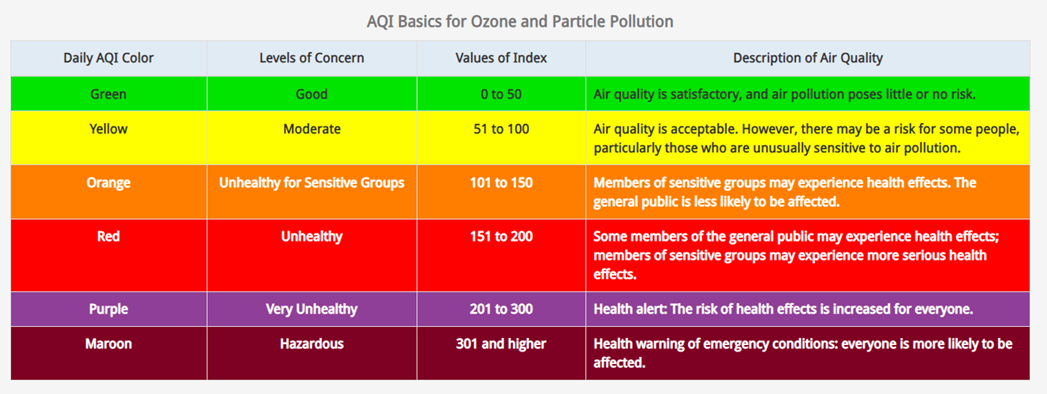- Executive Office of Labor and Workforce Development

Protect Outdoor Workers Exposed to Wildfire Smoke Polluted Air Flyer
Protect Outdoor Workers Exposed to Wildfire Smoke Polluted Air
Large-scale wildfire events across the western United States and Canada are becoming more frequent. Wildfires can produce unhealthy air pollution, therefore it’s important employers and employees understand the hazards of smoke exposure, related health effects, and how best to minimize such effects. Some working individuals, such as people with asthma, chronic obstructive pulmonary disease (COPD), or heart disease, and people who are pregnant are at an even higher risk for health problems.
Hazards
Wildfire smoke is a complex mixture of gases and particles from burning vegetation and other materials. The harmful chemicals and tiny particles suspended in wildfire smoke are a health hazard. The most significant hazard from wildfire smoke is exposure to tiny particles of partially burned material. These tiny particles can enter the lungs and even the bloodstream and are linked to serious health problems, including lung, heart, and kidney disease. Workers exposed to smoke-polluted air may also experience heat stress, eye and respiratory tract irritation, and suffer from exposure to other respiratory hazards.
What is an Air Quality Index (AQI)?
AQI is a measure of the quality of air in a certain area. The higher the AQI value, the greater the level of air pollution and the greater the health concern. The AQI is divided into six categories each corresponding to a different level of health concern indicated by specific colors. An AQI value of 50 or less represents good air quality. AQI values at or below 100 are considered satisfactory. AQI values greater than 100 indicate unhealth air quality. An AQI level over 300 represents hazardous air quality. airnow.gov/aqi/aqi-basics/
Employers Responsibilities
Employers should be aware that wildfire smoke may adversely affect the health of their workforce and prepare to take action to limit their workers’ exposures when a wildfire is emitting smoke in and around their work environment. Long work schedules and physical demands of the work performed (resulting in higher breathing rates) may impact a worker’s exposure and health response to wildfire smoke. Employers should have plans and preparations in place to protect workers from air pollution from wildfires by preventing or minimizing exposure to hazardous air quality.
Employers should frequently monitor air quality conditions in their area by visiting the Environmental Protection Agency (EPA) AirNow website airnow.gov/air quality website or the Massachusetts Department of Environmental Protection (DEP) MassAir Online website at eeaonline.eea.state.ma.us/dep/massair/web/#/pollution/map/ma. Staying indoors is recommended when air quality is at unhealthy levels, but for outdoor workers, this may not be possible. Here are some protective measures to reduce smoke exposure for outdoor workers:
- Frequent monitoring of air quality conditions using a source such as the EPA's AirNow at airnow.gov, or Mass DEP MassAir Online at eeaonline.eea.state.ma.us/dep/massair/web/#/pollution/map/max.
- Relocating or rescheduling work tasks to smoke-free or less smokey areas or times of the day.
- Reducing levels of physical activity, especially strenuous and heavy work.
- Requiring and encouraging workers to take breaks in smoke-free places when possible.
- If possible, make accommodations for employees to work inside with proper HVAC systems and high efficiency air filters.
- Provide or allow the use of NIOSH-approved respirators for voluntary use, when not otherwise required. When allowing respirators for voluntary use, employers must provide employees with the advisory information in Appendix D of OSHA’s Respirator Protection Standard at osha.gov/laws-regs/regulations/standardnumber/1910/1910.134AppD
- Provide training to employees on the signs and symptoms of smoke exposure so that they are aware and can monitor themselves and fellow workers. Mild symptoms of wildfire smoke exposure include coughing, runny nose, and eye irritation and inflammation, while more serious and sometimes fatal health effects include trouble breathing, asthma attacks, reduced lung function, chest pain, and heart attacks. Chronic effects of smoke exposure include reduced lung function, chronic bronchitis, worsening asthma, and heart failure.
Additional Resources
OSHA - osha.gov/wildfires
NIOSH - cdc.gov/niosh/topics/firefighting/wffsmoke.html
EPA - epa.gov/smoke-ready-toolbox-wildfires
CA Department of Industrial Relations - .dir.ca.gov/dosh/worker-health-and-safety-in-wildfire-regions.html
Oregon OSHA - osha.oregon.gov/pages/topics/wildfires.aspx

